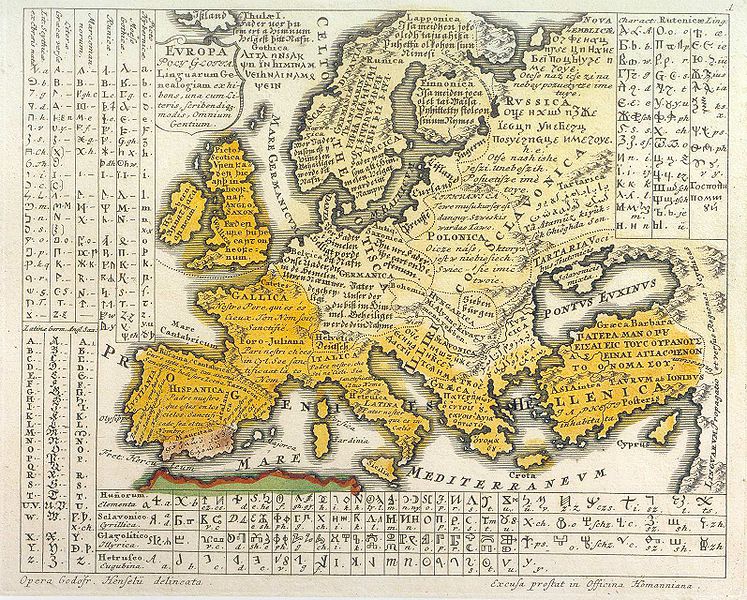File:Europa Polyglotta.jpg

Polna rezolucija ((1,593 × 1,279 pikselov, razměry obraza: 472 KB, tip MIME: image/jpeg))
Tutoj obraz nahodi se na Wikimedia Commons i može byti koristany od drugyh projektov. Jego opisanje jest pokazany poniže.
Summary
| DescriptionEuropa Polyglotta.jpg |
English: Gottfried Hensel: Europa Polyglotta, Linguarum Genealogiam exhibens, una cum Literis, Scribendique modis, Omnium Gentium.
"Multilingual Europe, showing the genealogy of the languages, together with the alphabets and modes of writing of all peoples." Around the map are charts of "Scythian" (based on Hebrew), Greek, "Marcomannic", Runic, Hibernian (insular), German (blackletter), Anglo-Saxon, "Ruthenian" (Cyrillic), "Hunnic" (Szekely-Hungarian Rovas), "Sclavonic" (Cyrillic), Glagolitic and Etruscan scripts. The map shows the first (two) phrase(s) of the pater noster ("our father who art in heaven. (hallowed be thy name.)") in 33 languages. The texts are based on Oratio dominica plus centum linguis versionibus (1700, 1715). [Germanic]
[Romance]
[Slavic]
[Other]
Latina: Europa Polyglotta, Linguarum Genealogiam exhibens, una cum Literis, Scribendique modis, Omnium Gentium. Magyar: Gottfried Hensel 1730-as Európa-térképe, melyen megtalálható a magyar rovás betűkészlet is. Latin betűs felirat pedig „HVNGARICA:
Mi Atyanc kivagy az mennyekben” |
| Date | |
| Source | Synopsis Universae Philologiae: In Qua: Miranda Unitas Et Harmonia Linguarum Totius Orbis Terrarum Occulta, E Literarum, Syllabarum, Vocumque Natura & Recessibus Eruitur immediate source: strangemaps.wordpress.com |
| Author | Gottfried Hensel |
| Other versions |
 |
Licensing
|
This is a faithful photographic reproduction of a two-dimensional, public domain work of art. The work of art itself is in the public domain for the following reason:
The official position taken by the Wikimedia Foundation is that "faithful reproductions of two-dimensional public domain works of art are public domain".
This photographic reproduction is therefore also considered to be in the public domain in the United States. In other jurisdictions, re-use of this content may be restricted; see Reuse of PD-Art photographs for details. | |||||
Captions
Items portrayed in this file
depicts
1741
image/jpeg
Historija obraza
Kliknite na datu/vrěme, da byste pozrěli obraz, kako izgledal onogda.
| Data/vrěme | Miniatura | Razměry | Koristnik | Komentar | |
|---|---|---|---|---|---|
| suča versija | 23:30, 3 fevruar 2008 |  | 1,593 × 1,279 (472 KB) | wikimediacommons>Nikola Smolenski | {{Information |Description={{la|Europa Polyglotta, Linguarum Genealogiam exhibens, una cum Literis, Scribendique modis, Omnium Gentium.}} |Source=[http://strangemaps.wordpress.com/2008/01/07/231-praise-the-lord-and-pass-the-dictionary/] |Date=1730 |Author |
Linki k obrazu
Slědujuča stranica linkuje k tutomu obrazu:
Metadata
This file contains additional information, probably added from the digital camera or scanner used to create or digitize it.
If the file has been modified from its original state, some details may not fully reflect the modified file.
| _error | 0 |
|---|